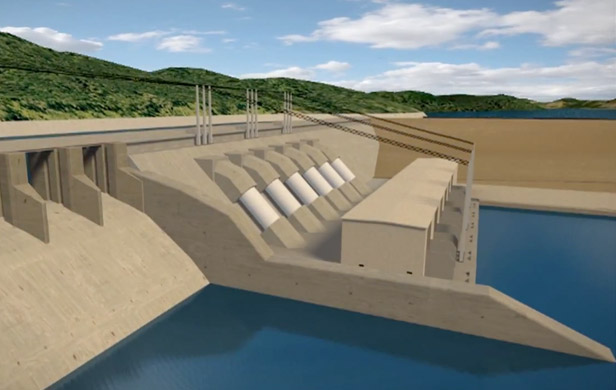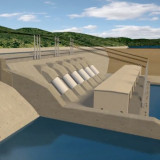
by Dene Moore, Canadian Press
FORT ST. JOHN, B.C. – The province of Alberta is concerned that a multibillion-dollar hydroelectric dam proposed in northeastern British Columbia could increase mercury levels in fish and escalate the risk of floods or drought along the Peace River that flows through its province.
Alberta’s Environment and Sustainable Resource Development, which manages lands, forests, fish and wildlife in the province, has filed a 23-page submission setting out its concerns to the panel reviewing the massive project.
Environmental review hearings for the $7.9-billion Site C dam proposal by BC Hydro are underway in Fort St. John, B.C.
Site C would be third strike against Peace River
Two existing dams on the Peace River in B.C. have already significantly altered the flow of the river into the neighbouring province, the Alberta submission said, and this has both positive and negative impacts in Alberta.
“Alberta is concerned that Site C will further exacerbate the negative impacts,” said the document filed Nov. 29.
The Site C dam would flood an 83-kilometre stretch of the Peace River from approximately Fort St. John to just upstream of Hudson’s Hope. It would be the third dam on the river, downstream from the W.A.C. Bennett and Peace Canyon dams.
The two existing dams already lower the river’s natural flow from May to late July, and increase flow from mid-October to mid-April. There are benefits to the flow regulation from BC Hydro, such as a reduced risk of flooding, but there are also risks, Alberta said.
Among those risks is an expected increase in methylmercury levels in fish during construction of the dam.
“Alberta acknowledges that BC Hydro expects increases in MeHg levels in fish populations downstream of the Alberta-B.C. border to be temporary and within fish consumption guidelines,” the submission said.
“However, it is unclear whether Albertans are aware of this increase, the amount of the increase, and the duration of the impact.”
The Alberta government requested ongoing information from BC Hydro to enable the province to inform fishermen on the Peace River of changes to methylmercury levels in fish until concentrations return to pre-construction levels.
Water flow, temperature changes
The impact of the dam on managing ice-related flooding and concern about minimum flow rates during construction were also singled out as concerns. Reduced peak flow affects the aquatic ecosystem on the Peace River, the Peace-Athabaska delta and other riparian wetlands, the document said.
Water fluctuations also cause mortality to fish and eggs by stranding, or indirectly through increased stress on fish, the report said.
There are also concerns about changes Site C will cause in water temperature downstream from the dam and reservoir, making the Peace River slower to warm in spring and slower to cool in summer.
“Such changes to water temperatures, though slight, may impact the current distribution and range of cold and cool water fish species within Alberta causing potential declines in some species and increases in others,” the report said. “Temperature changes may also impact the timing of ice freeze-up and break-up events.”
That could result in changes to spawning runs, in egg incubation rates and access to spawning habitat, the submission stated.
Dam could restrict fishing opportunities for Albertans
The province is also concerned about the flow of fish in the river. According to the report:
[quote]Upstream and downstream movement of fish populations is necessary for gene flow and hence long term resiliency in those populations, as well as to allow access to spawning, rearing, feeding, and overwintering areas.[/quote]
BC Hydro has told the neighbouring province that it is exploring options for fish passage, but as yet, “Site C could result in more restrictive fishing opportunities for species Albertans value more highly in the Peace River.”
Parks Canada raises issues with Site C
Parks Canada has also expressed concern about the cumulative effects another B.C. hydroelectric dam could have downstream, on Wood Buffalo National Park and the Peace Athabasca Delta.
The federal agency said the Athabasca Chipewyan First Nation, Fort Chipewyan Métis Association, Little Red River Cree Nation and Mikisew Cree First Nation share those concerns. The Athabasca Cree, Dene Tha’, Mikisew Cree and Deninu Kue First Nations, as well as the Metis Nation of Alberta Region 6, have registered to appear before the panel.
“It is Parks Canada’s view that assessment of the operational phase of Site C must include consideration of the impacts of sustained, ongoing operations of all three Peace River dams managed by BC Hydro to ensure adequate assessment and consideration of the cumulative effects of flow regulation,” Parks Canada wrote to the panel.


It is ironic that Alberta would cite environmental concerns in regards to its neighbours mega energy project while they are creating an open pit tar sands nightmare the size of North Carolina. What will be the effect on the fresh water fisheries in Saskatchewan, Manitoba, Ontario and beyond when the toxic waters and gases from Northern Alberta diffuse across the northern landscape?
Since the Harper Government is burning and dismantling the scientific libraries of Canada’s scientific community we will soon forget how pristine and productive the boreal forests once were. All this destruction so we can export energy to feed the unsustainable demands of an adolescent technological ‘civilization’ and the unquenchable demands of stock market shareholders and manipulators.
It is probably too late to stop this madness, too late to stop the greatest mass extinction of life ever to be witnessed on this planet, and too late to prevent the inevitable collapse of our unsustainable modern way of life. As the Arctic permafrost thaws out in the inevitable warming of the planet the released methane will dwarf mankind’s contribution to atmospheric greenhouse gases. We will have a runaway train-wreck on our hands and it will matter little who the fools were who once drove it.
Canada may be a small and insignificant country in terms of its population but we are going to have a starring role in the real-life horror film about the destruction of life on earth.
There’s something fishy about Albetar’s complaint. Like tom says, “since when did [Albetar] start worrying about fish?”
Could it be a tit-for-tat thing?…you know, if you don’t let Northern Gateway go through, we ain’t gonna let Site C go through…
Christy’s LNG dream is preposterous; we don’t need Site C, therefore. Not only does it cost money we don’t have, the Peace is some of the highest latitude productive agricultural land in the world. It’s dumb to flood it for no good reason. Christy, of course, has to champion it with a feat of circular logic to justify LNG. It has little else to recommend it—at least in the concept she has presented.
BC Hydro debt now over $15 billion, cost of Site C would add est. $8 billion of debt?
That doesn’t include $50 billion for IPP power. Or $1 billion for ‘smart grid’.
Interest on $23 billion debt, at 3%, is $690 million per year?
I guess that’s what deferral accounts are for.
Good, We don’t want or need this dam anyway…Cristy’s natural gas windfall has turned out to be a bad investment for BC….The more opposition the better who would flood thousands of acres of productive farmland that feeds people and is sustainable jobs forever not to mention the fish lost as well as the destruction of the mighty Peace River, Is this the BC we all want?
Hmmm… maybe be a client state of Alberta will have some upsides… ahhh, come to think of it, I doubt it. All hail TILMA NWPA…. and btw how is Alberta enjoying having a coast line?
NOT that I want the dam to go ahead … NO NO we dont need site C!!
Since when did Alberta start worring about FISH ,, with all there pipline plans that cross thousands of fish bearing rivers ???